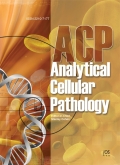Authors: Kayser, K. | Beyer, M. | Blum, S. | Kayser, G.
Article Type:
Research Article
Abstract:
Telepathology which is the diagnostic work of a pathologist at a distance has been developed to routine application within the last ten years. It can be classified in relation to application, technical solutions, or performance conditions. Diagnostic pathology performance distinguishes primary diagnosis (for example, frozen section statement) from secondary diagnosis (for example, expert consultation) and quality assurance (diagnostic accuracy, continuous education and training). Applications comprise (a) frozen section service; (b) expert consultations; (c) remote control measurements; and (d) education and training. The technical solutions distinguish active (remote control, live imaging) systems from passive (conventional microscope handling, static imaging), and the
…performance systems with interactive (on‐line, live imaging) use from those with passive (off‐line, static imaging) practice. Intra‐operative frozen section service is mainly performed with remote control systems; whereas expert consultations and education/training are commonly based upon Internet connections with static imaging in an off‐line mode. The image quality, transfer rates, and screen resolution of active and passive telepathology systems are sufficient for an additional or primary judgment of histological slides and cytological smears. From the technical point of view, remote control telepathology requires a fast transfer and at least near on‐line judgement of images, i.e., image acquisition, transfer and presentation can be considered one performance function. Thus, image size, line transfer rate and screen resolution define the practicability of the system. In expert consultation, the pixel resolution of images and natural color presentation are the main factors for diagnostic support, whereas the line transfer rate is of minor importance. These conditions define the technical compartments, especially size and resolution of camera and screen. The performance of commercially available systems has reached a high quality standard. Pathologists can be trained in a short time and use the systems in a routine manner. Several telepathology systems have been implemented in large Institutes of Pathology which serve for frozen section diagnosis in small hospitals located in the local area. In contrast, expert consultation is mainly performed with international connections. There is a remarkable increase of expert consultations by telepathology according to the experiences of the Armed Forces Institute of Pathology or the Department of Pathology, Thoraxklinik, Heidelberg. In expansion of these experiences, a “globalization” of telepathology can be expected. Telepathology can be used to shrink the period necessary for final diagnosis by request for diagnostic assistance to colleagues working in appropriate related time zones. Telepathology is, therefore, not a substitute of conventional diagnostic procedures but a real improvement in the world of pathology.
Show more
Keywords: Telepathology, frozen section service, expert consultation, active telepathology, passive telepathology
Citation: Analytical Cellular Pathology,
vol. 21, no. 3-4, pp. 101-106, 2000
Price: EUR 27.50





